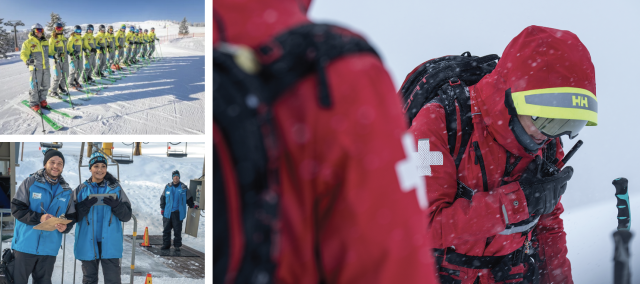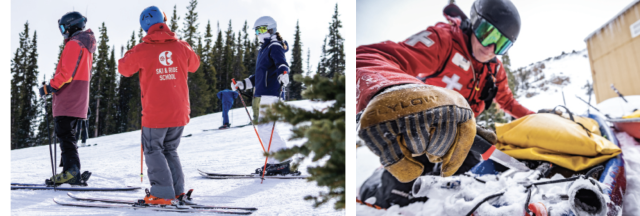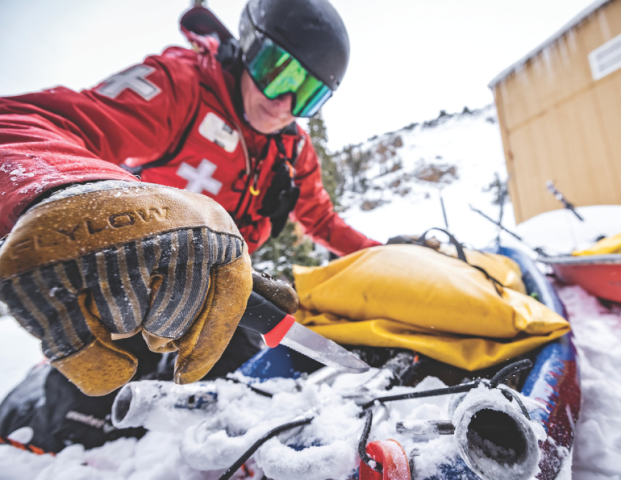Keeping ski area staffers comfortable while working outdoors in winter is big business. According to the National Ski Areas Association, ski area payrolls top 200,000. The Professional Ski Instructors of America and American Association of Snowboard Instructors (PSIA-AASI) has 33,000 members. The National Ski Patrol counts 30,000 in its membership. That’s a lot of parkas and pants. It’s also a lot of logos.
While wholesale suppliers have been a fixture in the resort uniform business, a few major consumer-facing brands are now dominating the space, namely Helly Hansen, Mammut, and The North Face. Other outerwear brands and accessory companies are keeping a hold in the market, though, often by pivoting, adapting, and partnering with independent resorts.
Consolidation in the uniform market has mirrored the consolidation and acquisitions in ski resorts. As multi-resort conglomerates such as Alterra Mountain Company, Vail Resorts, Boyne Resorts, Powdr, and Pacific Group Resorts, Inc. (PGRI), expand their portfolios, those big companies are leveraging the uniform buy.
Consumer-Facing Brands
Sales Through Storytelling
For consumer brands, uniforms are often a marketing tool. Occasionally, this makes employees into media stars. Big Sky, Mont., ski patroller Rachael Efta stars in a six-minute film that shows the resort’s patrollers donning Helly Hansen uniforms while battling winter’s harshest elements (and shredding pow) on the job. As the action fades to black, the tagline appears: “Trusted by Professionals,” followed by the Helly Hansen logo.
“We put professionals at the heart of our storytelling,” says Oliver Flaser, Helly Hansen category managing director, professional services. “It helps make our brand relevant.”
In the early 2000s, Helly Hansen launched its resort uniform program with the Resorts of the Canadian Rockies. Today the brand outfits more than 150 resorts, ski schools, and ski patrols around the world, including Vail Resorts and the Canadian Ski Patrol, which represents some 4,000 volunteer patrol members across 230 resorts.
“Our biggest strength is the combination of thoughtful design, continuous product evolution through listening to feedback from resort professionals, and the service provided by our customer operations team,” Flaser says.
Building Relationships Based on Avalanche Cred
At Mammut, based in Williston, Vt., avalanche safety products like the Barryvox transceiver were the genesis of Mammut’s uniform program. Once employees used the beacons, building trust in the brand, they began requesting uniforms. “If I look at the resorts we partner with on uniforms, it all started with a patrol order for the Barryvox, shovels, probes, and airbags years back,” says Keith Lennig, Mammut director of partnership sales North America. “We view the uniform as PPE for snow workers.”
Mammut designed its first uniforms for Zermatters and Crans Montana in Switzerland and partnered with Powdr and Jackson Hole Mountain Resort in 2019. It’s been growing the business ever since, outfitting 40,000 employees at 15 resorts across North America. “We basically doubled our resort partner portfolio this season,” Lennig says.
Powdr purchases Mammut for uniforms across the resort portfolio in one buy on a four-year uniform cycle. “The uniform market appears to be consolidating with only a few dominant players,” says Stacey Hutchinson, Powdr vice president of communications and government affairs. “Outfitting tens of thousands of resort staff demands substantial production capacity, intricate logistics, and product durability.
“Mammut has been a dedicated partner since the start,” she says. “Their collaboration involves immersing themselves in our operations, from team meetings to resort visits.” Indeed, Mammut prides itself on making design changes based on user feedback captured through direct polling and surveys.
 Clockwise from top left: Avalanche has provided uniforms for ski resorts and clubs across North America and Europe since 1986; Mountain Uniforms supplies Mountain High; Helly Hansen outfits more than 150 resorts, ski schools, and ski patrols, including the Vail Mountain ski patrol (photo credit Cam McLeod).
Clockwise from top left: Avalanche has provided uniforms for ski resorts and clubs across North America and Europe since 1986; Mountain Uniforms supplies Mountain High; Helly Hansen outfits more than 150 resorts, ski schools, and ski patrols, including the Vail Mountain ski patrol (photo credit Cam McLeod).
The Organization Angle
In 2024, when Patagonia left the uniform space and with it, the National Ski Patrol, Mammut stepped in. “[Patagonia’s departure] opened new opportunities for us,” Lennig says. Meanwhile, The North Face is the uniform sponsor for PSIA-AASI. The brand says the partnership is a way for it to connect directly with instructors, influential pros The North Face calls “super users.”
The Conglomerates
In 2019, as PGRI was adding resorts to its portfolio (the group owns six resorts, including Jay Peak, Vt., Mount Washington, B.C., and Powderhorn, Colo.), the company made Helly Hansen its official uniform supplier across all mountain departments. Most PGRI resorts had been independently using the brand anyway. “It was kind of a hodgepodge at the local rep level. We were looking for some economies of scale with purchasing,” says Mike Manara, director of mountain operations at Mount Washington.
PGRI looked for a brand with a purchasing cycle that allowed it to replenish uniforms as needed. “If you’re trying to change up the entire ski school, it’s quite expensive. Rather than dealing with crazy ebbs and flows of purchasing, we wanted to get into more of a maintenance process,” Manara says. “Part of the attraction of a Helly Hansen is the direct tie to our retail buying,” he says. “It creates opportunities for additional volume discounts and to leverage marketing.”
Within the Alterra lineup of resorts, each destination selects its uniform partner from the parent company’s outerwear brands of choice: The North Face and Helly Hansen. “This is in line with one of Alterra’s core principles: at each destination, leaders are empowered to be decisive, creative, and bold in order to retain each mountain’s authentic character,” says Alterra spokesperson Amelie Bruzat.
Alterra first partnered with The North Face in 2018 when the resort company was founded. Today, Stratton and Sugarbush in Vermont as well as Blue Mountain and Tremblant in Canada are among the destinations that use The North Face for uniforms. “The driving forces at the resorts are the super users like ski school and ski patrol. Function and fit are key in this arena,” says Teya Neff, The North Face communications manager, performance and impact. “The partnership also gives us an opportunity to connect with consumers at Alterra resorts year-round through traditional marketing executions and activations.”
The North Face also expands its reach by supplying uniforms to independent resorts like Mount Rose Ski Tahoe, Nev., and Monarch and Silverton, Colo.
Dedicated Uniform Brands
Staying Consistent
Mountain Uniforms has worked with about 400 ski areas over the years, with repeat business from resorts like Smugglers’ Notch, Vt., Diamond Peak, Nev., and Winterplace Resort, W.Va. The brand even supplies uniforms to the ice rink at Manhattan’s Rockefeller Center.
“Our sales model is different than vendors. We guarantee to offer the same style in the same color year after year for true uniformity,” says managing director Kim Stearns, who founded Mountain Uniforms in 1996. The brand also offers customization, from zipper pulls to embroidery.
While the resort sector is staying steady for the brand, Mountain Uniforms has garnered growth by offering uniforms to fire departments, law enforcement, and search and rescue.
The evolution to those new sectors stemmed from word of mouth. “We had a volunteer ski patroller who knew the brand, and he was also the captain at his local Idaho State Police,” Stearns says. “We used to be 80 percent ski and 20 percent public safety. Now we’re more like 50-50,” she says.
Avalanche Skiwear has been focusing on uniforms for ski resort staffs since 1986. The brand tailors its products to the pros with features like full-zip pants, abrasion-resistant fabrics, name tags, and radio pockets. Today, Avalanche supplies uniforms to 400 ski resort staffs and clubs across North America and Europe, from Colorado’s Steamboat to France’s Meribel Alpina. Ski resort uniforms are the DNA of the brand, but Avalanche has also expanded into industry-specific uniforms for search-and-rescue teams and firefighters.
“The ski uniform market is in constant motion,” says Stéphanie Lavoie, sales manager for Avalanche’s ski division. “If you want to stay in line, you must be proactive and listen to what people want.” More often, she says, customers are insisting that sustainability is built into uniforms. “Whether in our factories or in the materials used, we try to maintain a constant sustainable conscience.”
 Left to right: Copper Mountain sports Mammut uniforms; Patrol kits are part of Flylow’s niche (photo credit: Jay Dash).
Left to right: Copper Mountain sports Mammut uniforms; Patrol kits are part of Flylow’s niche (photo credit: Jay Dash).
Utility Product
Ski Area Supplies, a wholesaler based in Boulder, Colo., crafts ski resort uniforms using domestic materials. “The resort consolidation has definitely impacted our sales over the years,” says owner Mardee Kayser. “We used to get contracts to supply certain departments at major resorts, but department managers are no longer able to purchase outside of the uniform contracts negotiated with major apparel manufacturers.” Smaller resorts nationwide still turn to Ski Area Supplies for its flexibility around custom sizing, features, and branding.
While sales have ebbed in uniforms, the company has leaned into its best-selling Deluxe Maintenance Vest, a utility vest that holds communications gear, tools, and supplies, or rescue gear—and that the company customizes with colors, reflective tape, and embroidery. You’ll see the technicolored vests at Big Sky, Stratton, and even on Colorado’s Department of Transportation plow workers.
Small But Mighty
While the resort conglomerates are leaning into big buys with dominant players like Helly Hansen and Mammut, some independent resorts prefer the uniform-only brands. For the last eight years, Bogus Basin, Idaho, has been buying Mountain Uniforms for most departments, and then tapping different vendors for terrain park, ski patrol, and lift maintenance. The numbers are small; buys range from 75 to 300 uniform pieces every three years or so.
It’s important to Bogus Basin that its uniform partner can deliver consistency over time. “I believe in going with a brand that specializes in uniforms. The uniform companies retain fabric colors for an extended period of time and allow for re-orders and special sizing because this is their core business,” says Brad Wilson, Bogus Basin general manager. “Mountain Uniforms has been great about keeping our colors and allowing us to re-order to fill in quantities. Otherwise, we’d have a hodgepodge of uniform looks, and uniforms are supposed to be … uniform.”
Special Cases
Meanwhile, Bogus Basin’s terrain park crew has a more grassroots partnership for uniforms. The park’s 16 diggers and two snowcat operators wear Airblaster uniforms and ThirtyTwo snowboard boots. “I’ve chosen to partner with brands that have continued to support snowboarding and terrain parks,” says terrain park director Corey McDonald. “I firmly believe in building relationships with brands that align with what you have going at your resort.”
Burton takes a similar outlook to partnering with Powdr resorts. Staffers at Powdr resorts wear Mammut across most departments, except for Burton’s deal with Woodward Parks at Boreal and Soda Springs, Calif., and Woodward Park City, Utah. “Woodward has played a pivotal role in driving positive change in action sports for over 50 years, and we partner with them to drive snowboarding forward and inspire future generations to participate,” says Nate Benson, Burton senior director, marketing and consumer direct – Americas.
Other outerwear makers are still in the uniform game with partnerships on a smaller scale. Denver-based Flylow supplies patrol kits for resorts like Monarch Mountain, Colo., and Mt. Hood Skibowl, Ore., and works with heli-ski operations like Chugach Powder Guides, youth teams like the Loveland Freeride Club, and the education staff of the New Zealand Snowsports Instructors Alliance (NZSIA). “It’s worth it for us to have guides and freeride coaches and teams in our gear,” says Flylow co-founder Dan Abrams. “They’re the best skiers on the mountain. Lifties are not. Ski schoolers are not.”
Flylow is one of the suppliers used by Saddleback, which reopened in 2020. But the Maine resort doesn’t use a dedicated uniform brand across departments. “We’ve used several suppliers, including Stio, Flylow, Helly Hansen, and L.L. Bean, to name a few,” says PJ McSparran, the resort’s chief revenue officer.
 Hestra Job is an accessory-specific outerwear brand that supplies work gloves to mountain operations teams at more than 50 North American ski areas.
Hestra Job is an accessory-specific outerwear brand that supplies work gloves to mountain operations teams at more than 50 North American ski areas.
Other Considerations
The Sustainability Factor
Beyond the obvious uniform features, from durability to inclusive sizing to customization, ski resorts are considering a brand’s sustainability story. “PFAS are a really hot topic right now. There’s a lot of change happening in this space, and it’s not just uniforms. It’s every piece of outerwear that’s on the planet,” says Christian Knapp, PGRI chief marketing officer. “Sustainability is important to all of our properties and to our industry. You want your [uniform] partner to be on the cutting edge.”
Brands like Mammut tout their sustainability record as a selling point. “We’re not interested in selling a product that won’t last for a long time. It has to have a high standard for sustainability,” says Lennig. “Resorts are looking for a product that can perform for more ski seasons, which reduces the overall bottom line and the environmental impact.”
The Changing Sales Process
Most buying today takes place at the local level, not at trade shows as was once the case. “It’s helpful for people to be able to touch and feel the products and compare them in a live situation, but we haven’t seen as much attendance at shows since Covid,” says Stearns of Mountain Uniforms. The company attends some regional NSAA shows but relies more on Zoom and email to stay in touch with its customers.
“Our uniform deals are done in-house and without reps. We do business over Zoom and FedEx samples around,” says Flylow’s Abrams.
At Mammut, “Our uniform business is all about forging relationships, in person and usually on skis. We get out on the mountain to show the product in its intended environment. It’s very grassroots and hands-on,” Lennig says.
PGRI’s Manara sees one upside to this: “I feel like Covid took every traditional timeline and threw it out the window. It was chaos.” But the disruption ended up being a boon. “Today, the timing of our uniform buy is more aligned with our retail purchasing, and bringing the total volumes together makes it easier to apply discounts.”
Accessories
Accessory-specific companies also play the uniform game. Hestra Job works directly with mountain ops at 50+ ski resorts in the U.S. and Canada, including Vail Resorts, Mammoth, Calif., Jackson Hole Mountain Resort, Eldora, Colo., and the Yellowstone Club, Mont. The Swedish company is the exclusive work glove partner to the NSP and also partners with PSIA-AASI. “These partnerships have allowed us to stay in front of our target audience,” says Josh Jacobson, national sales manager for Hestra Job.
Those organizations help the glove maker connect with customers. “NSAA runs regional and seasonal events, and PSIA and NSP also host regional and national events that allow us to engage with patrollers and instructors,” Jacobson says. Rep locations like the Outdoor Market Alliance in Lakewood, Colo., are another way the brand gets its handwear in front of buyers.
Helly Hansen rounds out its uniform offering with accessories like radio harnesses, vest packs, gloves, and hats. And Alterra has marketing agreements with Dakine and Darn Tough; individual resorts work with those brands on packs and socks.
It Can Be Complicated
For resorts, the uniform buy can be complex. Ski areas have different on-mountain staffs with a range of needs, from lift ops to snowmakers to ski instructors to parking-lot attendants. The broad goal is to find uniforms that keep employees comfortable, dry, and warm in variable conditions. Resorts in the Pacific Northwest need uniforms that will keep staffers dry in wet weather, while low temps might be a more pressing issue at Eastern resorts. Inclusive sizing and sustainable products come into play, as does a brand’s ability to keep styles and colorways consistent from year to year to allow for uniform replenishing. It’s all about keeping uniforms uniform.






